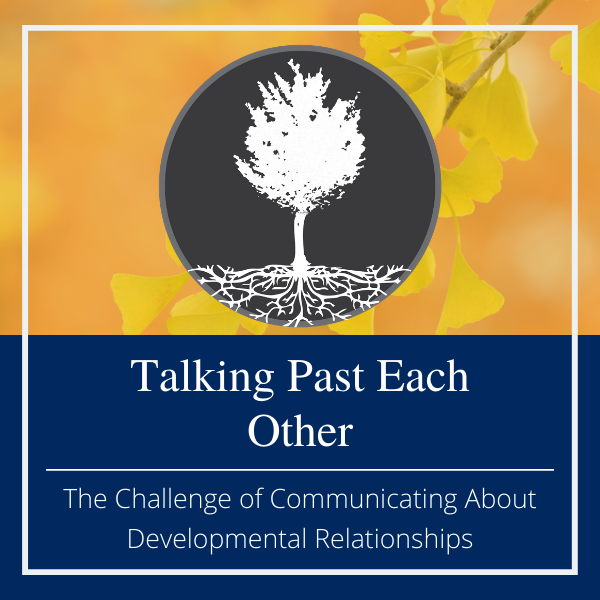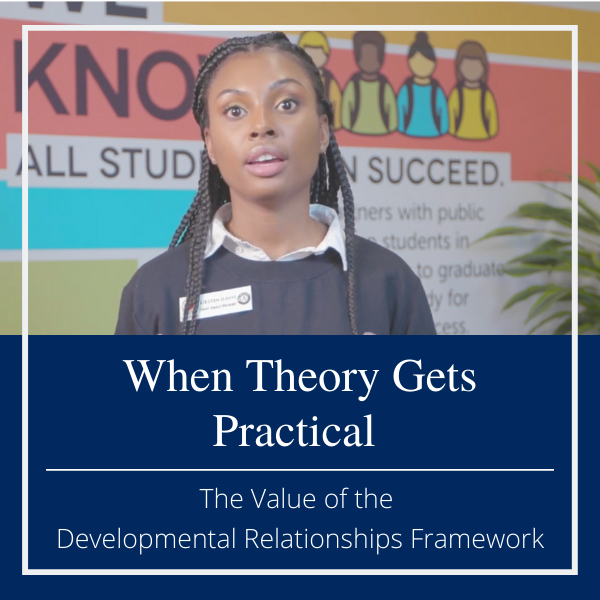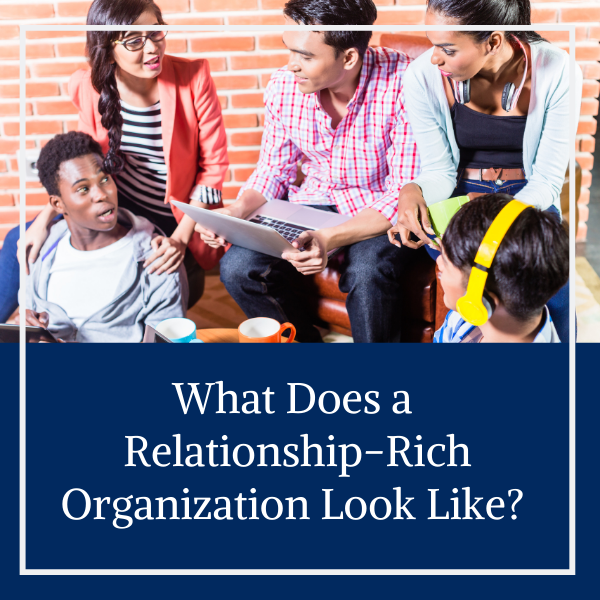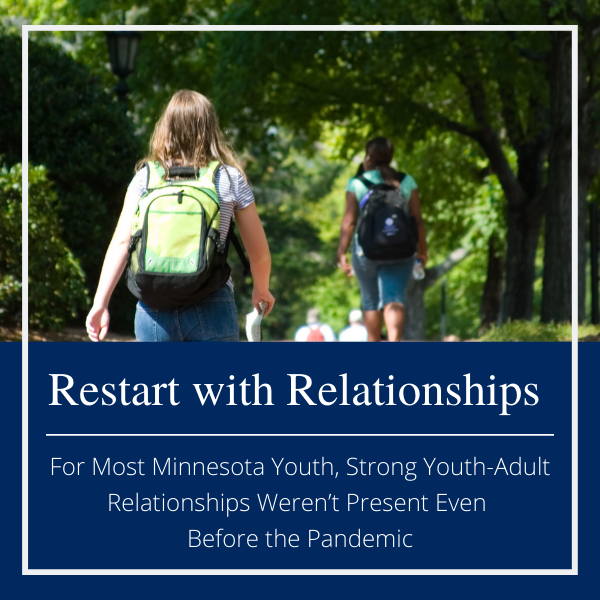Blog
Talking Past Each Other: The Challenge of Communicating About Developmental Relationships
By Eugene C. Roehlkepartain, Ph.D., Senior Scholar
 Saying relationships are important for a young person to learn and grow is like saying water is important for a swimming pool. A decade ago, one youth worker wrote something like (paraphrased slightly): “I’m still not sure whom the relational youth work fanatics think they are arguing against.”
Saying relationships are important for a young person to learn and grow is like saying water is important for a swimming pool. A decade ago, one youth worker wrote something like (paraphrased slightly): “I’m still not sure whom the relational youth work fanatics think they are arguing against.”
The conundrum is that, while everyone may say relationships matter, relationships don’t seem to be happening as widely as we would hope—or as meaningfully young people need.1
Why do we see this persistent gap between what we all seem to know is important and what actually happens? Of course, there’s always the intention-behavior gap between what we believe and how we act. But there’s more going on here, according to a FrameWorks Institute study on public perceptions of developmental relationships that Search Institute commissioned as part of the Relationships for Outcomes Initiative (ROI), which is the focus of this blog series.2
Same Word, Different Assumptions
Among FrameWorks’ findings on messages about developmental relationships, two in particular informed our work with the ROI partners (listed below) and reshaped how we communicate about developmental relationships. Those two findings are:
- There are profound disconnections between how most people think about relationships in young people’s lives and what the research shows is important. We’re talking past each other. As the FrameWorks researchers wrote, “Relationships require reframing because while people have an intuitive and profound understanding of some aspects of relationships, widespread cultural assumptions obscure other aspects.”
- Some core messages, if shared widely, have the potential of broadening and deepening people’s commitment to and investment in the lives of young people.
Some of the disconnections between public perceptions and a growing body of research from a wide variety of researchers are highlighted in the “Talking Past Each Other” sidebar. These and other gaps explain a lot of why everyone may agree that “relationships are important,” yet researchers keep finding that this society keeps giving inadequate attention to the kinds of relationships young people need. It appears that we collectively are, in fact, using the same word—relationships—but are assuming different things!
It’s no surprise, then, that FrameWorks’ final report called for “a profoundly different orientation toward relationships and—specifically—how our society should approach them collectively, through policies and programs.”
Talking Past Each Other
In its Mapping the Gaps study on developmental relationships, FrameWorks Institute identified significant gaps between how the general public thinks about relationships in young people’s lives and what researchers have found to be important for young people’s learning, resilience, and thriving. After engaging more than 6,300 people in the study, here are some of the differences they found:
- Who: The public thinks young people really only need relationships in their families. Other relationships are nice, but not necessary. Researchers argue that relationships with other adults and peers are also key for young people’s development.
- Influence: Researchers see relationships as being mutual, with both people influencing the other and both benefiting from the relationship. The public focuses only on the adult influencing the young person and the adult acting to benefit the young person.
- Agency: In the public’s mind, the young person is the recipient of what the adult does. Researchers see children as having an active role in the relationship and in their own development.
- Caring: The public sees relationships as being primarily if not only about caring. Researchers view relationships as being multi-dimensional, as demonstrated in the five elements of developmental relationships.
- Adversity: People in the public tend to believe that once children have experienced trauma or adverse experiences, they are “damaged for life.” Researchers point to evidence that supportive relationships, in particular, help to address the harm caused by trauma and buffer against negative outcomes.
Communicating Developmental Relationships Through Metaphor
Where do we start? Through their extensive research on reframing issues for social change communications, FrameWorks consistently finds that well-chosen, well-tested metaphors “can spark new associations and understandings, putting an issue in a new light and prompting people to rethink their opinions or assumptions.” They continue: “When we need to shift widely shared mindsets, the right metaphor can make the difference.”
FrameWorks tested a wide range of potential metaphors through on-the-street interviews, thousands of online surveys, and focus groups to test what resonated, how people interpreted them, and what motivated them to support a broader understanding of developmental relationships. The metaphor that consistently tested well across all demographic groups is simple:
Developmental relationships are the roots of success.
Or, developmental relationships are the roots of resilience and thriving.
The roots metaphor immediately shifted people’s mindsets to think differently about relationships. “The Roots of Success explanatory metaphor helps people understand that young people can have developmental relationships with many different people in many different spaces,” FrameWorks found, “and that these environments, if structured properly, can actively support these relationships.” Of all the metaphors tested, Roots of Success was “the most effective in shifting how people think about developmental relationships” (pp. 15-16).
The notion of roots is evocative as you consider the role of roots in the life of a plant. Plants and trees need multiple roots. Different species have different types of root systems. Different roots serve different functions. Roots keep a plant stable and buffer trees against storms. Roots provide nutrients while also exchanging nutrients with leaves. The conversation and the associations can continue productively, opening up new ways to consider how we as a society think about relationships in young people’s lives.3
Communicating Through Images
FrameWorks offered the metaphor to communicate about developmental relationships. Search Institute also wanted visual images that communicate in a different way. For that, we turned to Design & Agency, a trans-disciplinary design studio of Augsburg University students, faculty, and community members that co-create communications, marketing, and other solutions aimed at creating good in the world.
We presented the design team with our challenge, and they asked lots of questions: What kind of roots? What kind of plant? Does it have to be roots on a tree? What about a cactus? Or grass? Is it just one? What about community or groves of trees? You could make a case for any of those! So, the possibilities of roots and relationships kept expanding!
Then the design team introduced us to the ginkgo biloba4—also known as the Maidenhair tree—which is considered the world’s oldest living plant species. Charles Darwin called it “living fossil” because it survived unchanged from its form in fossils from more than 200 million years ago. Fossils of its leaves have been found on every continent.
Once you start noticing ginkgo, you can see them almost everywhere. (They are among the most commonly planted trees in Tokyo and New York City.)
- They have distinct, heart-shaped leaves, which are the inspiration for the icons for each of the five elements of developmental relationships.
- They are ever-changing, offering jaw-dropping displays of bright, yellow leaves each autumn.
- They are hardy and resilient, doing well in urban environments, dry climates, and cold winters. Their deep roots also make them resistant to wind and snow damage. They can even form aerial roots that sprout a new tree when the roots touch soil. That makes it uniquely resilient as a species.
The design team used the leaves of the ginkgo to inspire icons for the elements of developmental relationships. Like a metaphor, they are intended to be more symbolic and evocative than representative and descriptive. So, perhaps, we’ll build on the metaphorical connections to explore ways to think about relationships and roots inspired by the ginkgo tree:
Developmental relationships are the roots of young people’s resilience and thriving.
![]()
ExpressCare
• They nourish young people’s strengths.
• Trees and roots “know” they can depend on each other.
![]()
Challenge Growth
• Trees and roots work together to grow. If they’re not growing, they’re dying.
• If a branch breaks or a root is cut, they regroup and grow in new directions.
![]()
Provide Support
• Relationships hold young people up through life’s storms. They are a source of stability.
• Developmental relationship builders go out of their way to find what young people need, just as roots search for what a tree needs.
![]()
Share Power
• Relationships are two way. For the tree to survive, the roots, the trunk, branch, and leaves all have to contribute and all work together. They mutually depend on each other.
• In different seasons leaves, roots, and trunks have somewhat different roles. Isn’t the same true in relationships?
![]()
Expand Possibilities
• They connect young people to resources in their environment.
• Roots grow into new places when the tree isn’t getting the nourishment it needs. Relationships can grow and open up new possibilities, keeping each other learning, growing, and thriving.
Are those the best extensions of the Roots of Success metaphor? Perhaps not. You may think of others that motivate you and people you know to think more broadly about who has a responsibility and opportunities to cultivate relationships with young people. Go with it! You may think of other extensions of the Roots of Success metaphor that broaden how you or others think about what happens in a relationship—that caring alone isn’t enough. Excellent!
If the words or the images help to reframe and expand our mindsets about relationships and move more people to engage more fully with young people, then we can celebrate forward movement. We can move beyond insisting that “relationships matter” to investing in the kinds of developmental relationships that all young people need to be rooted in relationships in each and every part of their lives.
Published Blog in this 5-Part Series
- When Relationships Get Practical: The Value of the Developmental Relationships Framework
More insights from the ROI project
Notes
1 For evidence, see two recent Search Institute reports on developmental relationships and equity and on relationships in Minnesota schools and youth organizations.
2 ROI was a three-year partnership focused on discovering what it takes to become a relationship-rich youth-serving organization with the ultimate goal of improving outcomes for young people, particularly those from marginalized communities.
3 Check out FrameWorks’ tools to shape your own messages in their free toolkit on developmental relationships.
4 For much more information about the ginkgo see: Crane, P. R., Crane, P., & von Knorring, P. (2013). Ginkgo: The tree that time forgot. New Haven, CT: Yale University Press.
ROI Partners
These five youth-serving organizations partnered with Search Institute in Relationships for Outcomes (ROI). Each partner included a local “design site” where we collaboratively listened to youth, staff, and parents, prototyped and tested tools, gathered feedback, and collected data.
 |
 |
 |
 |
 |
| Camp Fire Columbia Council , Portland, OR |
Communities in Schools in San Antonio Program at South San Antonio High School, TX |
Office in Boston, MA |
National Center for Families Learning Toberman Neighborhood Center, San Pedro, CA |





